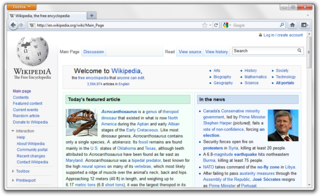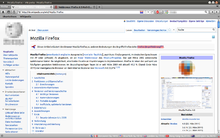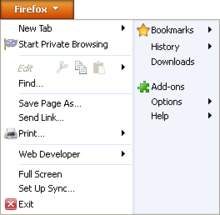- Firefox 4
-
Mozilla Firefox 4 


Firefox 4.0 on Windows 7.Original author(s) Mozilla Corporation Developer(s) Mozilla Corporation
Mozilla FoundationInitial release March 22, 2011[1] Stable release 4.0.1 (April 28, 2011) [+/−] Preview release [+/−] Written in C++, JavaScript,[2] CSS,[3][4] XUL, XBL Operating system Cross-platform Engine Gecko Size 11.9 MB - Windows
26.8 MB - Mac OS X
13.2 MB - GNU/LinuxAvailable in 81 languages Development status End of life Type Web browser
FTP clientLicense MPL/GNU GPL/GNU LGPL[5] Website firefox.com  Customized Firefox 4 on Ubuntu
Customized Firefox 4 on Ubuntu

(category)Contents - Firefox 7 · 8 · 9 · 10
- Firefox 4 · 5 · 6
- Firefox 3.6
- Firefox Portable
- History of Firefox
- Features of Firefox
- Gecko
- Add-ons
- Extensions
- Firefox market adoption
Origins and lineage Mozilla Firefox 4 is a version of the Firefox web browser, released on 22 March 2011.[6] The first beta was made available on 6 July 2010; Release Candidate 2 (a base for the final version) was released on 18 March 2011.[7][8] It was codenamed Tumucumaque,[9] and has been confirmed as Firefox's last large release cycle. The Mozilla team planned smaller and quicker releases following other browser vendors.[10] The primary goals for this version included improvements in performance, standards support, and user interface.[11]
There was one security update in April 2011 (4.0.1) and version 4 of the browser was made obsolete by the release of Firefox 5 in June 2011.[12]
This marked a transition to giving much less weight to major version numbers, with 5 more major version numbers used by September of that year (5,6,7,8, and 9), compared to 4 in nearly a decade of Firefox development (1,2,3,4).
Contents
History
On 13 October 2006, Brendan Eich, Mozilla's Chief Technology Officer, wrote about the plans for "Mozilla 2", referring to the most comprehensive iteration since its creation of the overall platform on which Firefox and other Mozilla products run.[13] Most of these objectives were incorporated into versions 3.0, 3.5, and 3.6. The largest changes, however, were deferred to Firefox 4.0.
In early May 2010, Mozilla's plans for Firefox 4.0 were officially detailed through a blog post by Mike Beltzner, Firefox director.[11]
On 25 May 2011, the Firefox release manager wrote in an email "Firefox 5 will be the security update for Firefox 4," confirming Firefox 4 had entered its "end of life" phase where Mozilla will no longer issue updates. Mozilla continued to issue updates for Firefox 3.6 after 4's EOL declaration. Only one update (4.0.1) was issued for Firefox 4 during its lifetime. Many looking for a copy of this version 4 will be directed to version 6 which won't work on earlier Mac Apple computers.[12]
Features
Mozilla Firefox 4 includes many new features since version 3.6.[14]
User interface
Firefox 4 brings a new user interface, with a new look designed to make it faster.[15] Early mockups of the new interface on Windows,[16] Early mockups of the new interface on Windows,[17] Mac OS X,[18] and Linux[19] were first made available in July 2009.
New features include improved "doorhanger" notifications, Firefox Panorama (a feature that lets the user organize tabs into windows called "groups" and perform various operations on groups),[clarification needed][20] application tabs, a redesigned extension manager,[21] Jetpack extensions support, integration with Firefox Sync,[22] and support for multitouch displays.[23]
Many changes were made to the user interface. By default, tabs are now on the top of the window.[24] The "stop" "reload" and "go" buttons have been combined into a single button, placed on the right side of the address bar. The button changes dynamically based upon the current state of the page.[25] On Windows Vista and Windows 7, the menu bar is hidden by default with the most common actions moved to a new "Firefox" menu in the upper left hand corner of the browser. Users can create persistent "app tabs", and customize the tab bar, as well as the bookmark and navigation bars.[citation needed]
Engine
Firefox 4 is based on the Gecko 2.0 engine, which adds and improves support for HTML5,[26] CSS3, WebM, and WebGL.[11] Also, it includes a new JavaScript engine (JägerMonkey)[27] and better XPCOM APIs.
JägerMonkey is a new JavaScript engine designed to work alongside the TraceMonkey engine introduced with Firefox 3.5. It improves performance by compiling "non-traceable" JavaScript into machine language for faster execution.[28]
Firefox 4 is the first version of Firefox to drop native support of the Gopher protocol; however, continued support is available through an add-on.[29]
Firefox 4 introduces an audio API, which provides a way to programmatically access or create audio data associated with a HTML5 audio element.[30] It allows, for example, to visualize raw sound data, to use filters or to show the audio spectrum.[31]
Firefox 4 no longer relies on the underlying OS for text layout/shaping. Instead, it uses HarfBuzz. This allows for smart OpenType layout/shaping which is consistent across different operating systems.
Performance
Firefox 4 has marked a major change in performance in comparison to former versions 3.6 and 3.5. The browser has made significant progress in Sunspider JavaScript tests as well as improvements in supporting HTML5.[32]
Since Firefox 4.0 Beta 5, hardware acceleration of content is enabled by default on Windows Vista and Windows 7 machines using Direct2D, on OS X using Quartz (basically CPU-only), and Linux using XRender. Hardware acceleration of compositing is enabled by default on XP, Vista and 7 machines using Direct3D, OS X and Linux using OpenGL.[33] Using hardware acceleration allows the browser to tap into the computer's graphics processing unit, lifting the burden from the CPU and speeding up the display of web pages. Acceleration is only enabled for certain graphics hardware and drivers.[34]
Privacy
Firefox 4 contains support for the "do not track" header, an emerging standard for Web privacy.[35] The header signals the user's request to the web service that any web visitor tracking service be disabled. In the future, this privacy request may become a legal requirement.[36]
Development
Nightly builds were marked as 4.0a1pre between February and June 2008,[37][38] but were renamed to 3.1a1pre afterwards.
Timeline
Release Release date Notes Alpha 1 10 February 2010.[39][40] Firefox 3.7 (Gecko 1.9.3) Alpha 2 1 March 2010 Alpha 3 17 March 2010 Alpha 4 12 April 2010 Alpha 5 16 June 2010 Beta 1 6 July 2010 The version number was changed to 4.0 (Gecko's 2.0) Beta 2 27 July 2010 Beta 3 11 August 2010 Beta 4 24 August 2010 Beta 5 7 September 2010 Beta 6 14 September 2010 Beta 7 10 November 2010 Originally scheduled for the second half of September, but was delayed in order to stabilize the new JavaScript engine and finish the planned features Beta 8 22 December 2010 Beta 9 14 January 2011 Beta 10 25 January 2011 Beta 11 8 February 2011 Ship eleventh revision of beta, with more betaN+ hardblockers fixed (14 betaN+ hardblockers not fixed) Beta 12 25 February 2011 Ship twelfth revision of beta, with all betaN+ hardblockers fixed. Mozilla senior engineering director Damon Sicore, urging his team to take this hill and push through to ship a release candidate by 25 February.[41][42][43] RC 1 9 March 2011[44] Complete work on all blocking 2.0:final + bugs, generate release candidates RC 2 18 March 2011[45] Two very small, very isolated fixes in order to better protect Firefox 4 users. 4.0 22 March 2011 Release final version of Firefox 4.0.[46] 4.0.1 28 April 2011 Fixed several security and stability issues. Reception

market share overview
According to StatCounter dataOctober 2011[47][dated info]
Browser % of Fx % of Total Firefox 1 -- -- Firefox 1.5 -- -- Firefox 2 0.37% 0.1% Firefox 3 1.85% 0.5% Firefox 3.5 2.96% 0.8% Firefox 3.6 25.34% 6.84% Firefox 4 5.22% 1.41% Firefox 5 5.41% 1.46% Firefox 6 36.09% 9.74% Firefox 7 22.82% 6.16% Other[FF 1] 0.03% 0.01% All variants[48] 100.00% 26.99% - ^ 'Other' mostly consists of Firefox 3.1
which is a series of betas for 3.5.
During the 24-hour launch period starting on 22 March 2011, Firefox 4 was downloaded 7.1 million times as counted by Mozilla's download stats site glow.mozilla.org and verified by Mozilla.[49] Before the official launch, more than 3 million people had downloaded the second release candidate, which became the final version,[50] resulting in a total of over 10 million downloads by the end of the launch day.[51] In terms of the number of downloads for the first 24 hours, it failed to surpass the record-setting 8 million downloads attained by Firefox 3 in 2008. Downloads for the second day, however, were reported to be over 8.75 million in number, but because no on-site official from Guinness was there to monitor the numbers, the record attained by Firefox 3 has only unofficially been broken.[49]
See also: Usage share of web browsersUsage share on official launch day was 1.95%, which is 0.34% higher than the day before according to website analytics company StatCounter.
For comparison, Internet Explorer 9 usage share on 22 March 2011 was 0.87%,[52] having launched about a week before on 14 March 2011. One potential reason for Firefox 4's higher usage share is the support for Windows XP and Windows 2000, which Internet Explorer 9 does not have.
However, at launch, Firefox enacted a method to prompt existing customers to upgrade, while IE users have not been prompted in such a manner.[53] Instead, Microsoft prompts IE users to upgrade via Windows Update several weeks after launch.
On 26 March 2011, Firefox 4 usage share exceeded the discontinued, 10 year old Internet Explorer 6 for the first time. On that date, 4 days after official launch day, Firefox 4 usage share was greater than that of all versions of Safari and Opera as well as all older versions of Firefox except Firefox 3.6. [54] For comparison, Internet Explorer 9 usage share first exceeded that of Internet Explorer 6 on 1 May 2011 (48 days after release) and Internet Explorer 9 became the second most used Internet Explorer version for the first time on 22 May 2011 (69 days after release).
On the 19 June 2011 Firefox 4 reached its peak at 16.7% according to StatCounter. After that date, usage declined slightly due to weekly trends then dropped quickly due the release of Firefox 5.
Migration issues
Firefox 4 represents a departure in user interface layout and behaviour from previous versions.[55] Users face some issues negotiating these changes, some of which are not documented in the release notes.[56]
Firefox button
The Firefox button groups the menus in Firefox 4. It is displayed by default on the Windows 7 and Windows Vista operating systems.[57] It can be displayed on other operating systems by selecting "Toolbars" from the View menu and unchecking "Menu Bar". The Menu bar can be restored by selecting "Options" from the Firefox button menu and checking "Menu Bar". Certain menu items, such as "Page Info" and "Import" (for importing bookmarks and other browser data), are not available from the Firefox button menu but remain available from the Menu bar.[58] The Menu bar can be displayed temporarily by pressing and releasing the Alt key.[59] Selecting a Menu bar command or pressing the Alt key again dismisses the Menu bar.
Session data
A prompt to save the session (tabs and windows) was presented by default in Firefox 3, with the session restored on next start if the user selected the "Save & Quit" option. In Firefox 4, all sessions are saved. On next start, the session is available from the History menu.[60]
This new feature, called on-demand session restore, overwrites the previous session on exit without prompting. The user can check whether there is a saved session at any time by viewing the History menu item "Restore Previous Session".[61] If it is available (not greyed out) there is a restorable session available.
References
- ^ "Releases – Mozilla Wiki". Mozilla. https://wiki.mozilla.org/Releases. Retrieved 16 March 2011.
- ^ "Firefox's addons are written in JavaScript". Rietta.com. http://www.rietta.com/firefox/Tutorial/backend.html. Retrieved 19 December 2009.
- ^ "Firefox uses an "html.css" stylesheet for default rendering styles". Davidwalsh.name. http://davidwalsh.name/firefox-internal-rendering-css. Retrieved 19 December 2009.
- ^ "The Firefox addon, Stylish takes advantage of Firefox's CSS rendering to change the appearance of Firefox". Userstyles.org. http://userstyles.org/styles;app. Retrieved 19 December 2009.
- ^ "Mozilla End-User Licensing Agreements". Mozilla.com. Mozilla Foundation. http://www.mozilla.com/en-US/legal/eula/. Retrieved 8 November 2010.
- ^ Channelreigster.co.uk
- ^ Firefox/4/Beta "MozillaWiki". Wiki.mozilla.org. 8 February 2011. https://wiki.mozilla.org/Firefox/4/Beta Firefox/4/Beta. Retrieved 10 February 2011.
- ^ ZDnet.com
- ^ "Tumucumaque Park". Mozilla.org. 5 October 2010. http://www.mozilla.org/parks/tumucumaque/?WT.mc_id=wwf&WT.mc_ev=click. Retrieved 26 January 2011.
- ^ "Last Release". PC Pro. 28 February 2011. http://www.pcpro.co.uk/news/365602/mozilla-firefox-4-will-be-our-last-big-release. Retrieved 3 March 2011.
- ^ a b c Beltzner, Mike (10 May 2010). "Firefox 4: fast, powerful, and empowering". http://beltzner.ca/mike/2010/05/10/firefox-4-fast-powerful-and-empowering/. Retrieved 21 September 2010.
- ^ a b http://www.computerworld.com/s/article/9217837/Mozilla_retires_Firefox_4_from_security_support
- ^ Eich, Brendan (13 October 2006). "Mozilla 2". http://weblogs.mozillazine.org/roadmap/archives/2006/10/mozilla_2.html. Retrieved 16 September 2006.
- ^ "Firefox 4.0 beta 6 release notes". http://www.mozilla.com/en-US/firefox/4.0b6/releasenotes/. Retrieved 7 July 2010.
- ^ "Mozilla spills plan for, yes, Firefox 4". The Register. 10 May 2010. http://www.theregister.co.uk/2010/05/10/firefox_4_dot_o_plan/. Retrieved 10 May 2010.
- ^ "Mozilla spills plan for, yes, Firefox 4". The Register. 10 May 2010. http://www.theregister.co.uk/2010/05/10/firefox_4_dot_o_plan/. Retrieved 10 May 2010.
- ^ "Firefox 4.0 Windows Theme Mockups". Mozilla. 2 June 2010. https://wiki.mozilla.org/Firefox/4.0_Windows_Theme_Mockups. Retrieved 11 August 2010.
- ^ "Firefox 4.0 Mac Theme Mockups". Mozilla. 16 June 2010. https://wiki.mozilla.org/Firefox/4.0_Mac_Theme_Mockups. Retrieved 11 August 2010.
- ^ "Firefox 4.0 Linux Theme Mockups". Mozilla. 21 July 2010. https://wiki.mozilla.org/Firefox/4.0_Linux_Theme_Mockups. Retrieved 11 August 2010.
- ^ Aza Raskin. "Firefox Panorama: Tab Candy Evolved". http://www.azarask.in/blog/post/designing-tab-candy/. Retrieved 11 September 2010.
- ^ Stephen Shankland (11 May 2010). "Firefox 4 release plan: The need for speed". cnet. http://news.cnet.com/8301-30685_3-20004620-264.html. Retrieved 28 May 2010.
- ^ "Sync in Firefox 4 Beta". Mozilla Labs. 24 August 2010. http://mozillalabs.com/sync/2010/08/24/sync-in-firefox-4-beta/. Retrieved 11 September 2010.
- ^ Stephen Shankland (28 May 2010). "Mozilla prepares coders for Firefox 4 features". cnet. http://news.cnet.com/8301-30685_3-20006239-264.html. Retrieved 28 May 2010.
- ^ Why Tabs are on Top in Firefox 4 « Alex Faaborg. Blog.mozilla.com (24 June 2010). Retrieved on 8 November 2010.
- ^ "Firefox/4.0 Windows Theme Mockups – MozillaWiki". Mozilla. 27 July 2009. https://wiki.mozilla.org/Firefox/4.0_Windows_Theme_Mockups. Retrieved 10 August 2009.
- ^ Henri Sivonen (11 May 2010). "Firefox 4 HTML 5 parser". http://hacks.mozilla.org/2010/05/firefox-4-the-html5-parser-inline-svg-speed-and-more/. Retrieved 11 May 2010.
- ^ Christopher Blizzard (8 March 2010). "a quick note on JavaScript engine components". http://hacks.mozilla.org/2010/03/a-quick-note-on-javascript-engine-components/. Retrieved 19 March 2010.
- ^ David Mandelin (26 February 2010). "Starting JägerMonkey". http://blog.mozilla.com/dmandelin/2010/02/26/starting-jagermonkey/.
- ^ "Firefox 4 for Developers – MDC". 25 August 2010. https://developer.mozilla.org/en/Firefox_4_for_developers#Other_changes_2.
- ^ "Audio Data API". Mozilla. 25 August 2010. https://wiki.mozilla.org/Audio_Data_API. Retrieved 29 September 2010.
- ^ IB Times Staff Reporter (8 September 2010). "Firefox 4 beta flaunts audio API to create music visuals". International Business Times. http://www.ibtimes.com/articles/60496/20100908/mozilla-firefox-4-beta-api-browser.htm. Retrieved 29 September 2010.
- ^ jsullivan (10 November 2010). "Fasten Your Seatbelts – Firefox 4 Beta adds new JavaScript power and faster graphics". http://blog.mozilla.com/blog/2010/11/10/fasten-your-seatbelts-latest-firefox-4-beta-boosts-speed-in-the-browser/. Retrieved 10 November 2010.
- ^ "Firefox 4: hardware acceleration". Mozilla. 7 September 2010. http://hacks.mozilla.org/2010/09/hardware-acceleration/.
- ^ [1]
- ^ Mossberg, Walt (31 March 2011). "New, Lean Firefox 4: Re-Built to Play Catch-Up". Wall Street Journal. http://online.wsj.com/article/SB10001424052748704471904576230923249332158.html?mod=googlenews_wsj. Retrieved 31 March 2011.
- ^ Valentino-DeVries, Jennifer (14 March 2011). "Firefox Maker: 'Do Not Track' Likely to Be Regulated". Wall Street Journal Blogs. http://blogs.wsj.com/digits/2011/03/14/firefox-maker-do-not-track-likely-to-be-regulated/?mod=google_news_blog. Retrieved 31 March 2011.
- ^ FTP.Mozilla.org
- ^ FTP.Mozilla.org
- ^ "Platform/2010-02-02 – Mozilla Wiki". Mozilla. 2 February 2010. https://wiki.mozilla.org/Platform/2010-02-02#Notices_.2F_Schedule. Retrieved 6 February 2010.
- ^ Release Notes: Mozilla Developer Preview. Mozilla.org. Retrieved on 8 November 2010.
- ^ "Firefox 4 RC targeted for Feb 25, final by March". http://www.neowin.net/news/firefox-4-rc-targeted-for-feb-25-final-by-march.
- ^ "Mozilla confirms Firefox 4 beta 12 is FINAL test build". http://www.theregister.co.uk/2011/02/25/firefox_4_beta_12_final_before_release_candidate/.
- ^ "Releases Mozilla Wiki". https://wiki.mozilla.org/Firefox/4/Beta.
- ^ "Mozilla Firefox 4 RC Release Notes". http://www.mozilla.com/en-US/firefox/4.0rc1/releasenotes/. Retrieved 9 March 2011.
- ^ "Mozilla Firefox 4 RC Release Notes". http://www.mozilla.com/en-US/firefox/4.0rc2/releasenotes/. Retrieved 18 March 2011.
- ^ "Damon Sicore announces possible Firefox 4.0 final launch date in the official Mozilla Google Groups page.". https://groups.google.com/forum/?pli=1#!topic/mozilla.dev.planning/GKNHlW5Gk-s/.
- ^ Top 12 Browser Versions on October 2011 StatCounter Global Stats
- ^ Top 5 Browsers on October 2011 StatCounter Global Stats
- ^ a b Keizer, Gregg (27 March 2011). "Firefox 4 sets unofficial download record". Computer World. http://www.computerworld.com/s/article/9215243/Firefox_4_sets_unofficial_download_record. Retrieved 29 March 2011.
- ^ Blog.mozilla.com
- ^ The Inquirer.net
- ^ GS.statcounter.com
- ^ "A thoughtful approach to measuring browser adoption". 2011mar29. http://windowsteamblog.com/ie/b/ie/archive/2011/03/29/a-thoughtful-approach-to-measuring-browser-adoption.aspx.
- ^ http://gs.statcounter.com/#browser_version-ww-daily-20110326-20110326-bar
- ^ "Mashable review". http://mashable.com/2011/03/23/firefox-4-review/. Retrieved 1 April 2011.
- ^ "Firefox 4.0 release notes". http://www.mozilla.com/en-US/firefox/4.0/releasenotes/. Retrieved 1 April 2011.
- ^ "Firefox 4.0 release notes". http://www.mozilla.com/en-US/firefox/4.0/releasenotes/. Retrieved 1 April 2011.
- ^ "Firefox Help: Page Info window". http://support.mozilla.com/en-US/kb/Page%20Info%20window?s=page+info&as=s. Retrieved 1 April 2011.
- ^ "howto-guidebook.com: Bookmark import guide". http://www.howto-guidebook.com/how-to-import-bookmarks-into-firefox-4. Retrieved 3 April 2011.
- ^ "Mozilla Firefox Developer Forum". http://groups.google.com/group/mozilla.dev.apps.firefox/msg/025ea6c5ff307346?hl=en. Retrieved 1 April 2011.
- ^ "Blog post by Firefox developer Paul O’Shannessy". http://blog.zpao.com/post/1099464627/restore-previous-session. Retrieved 1 April 2011.
External links
Mozilla Project Mozilla LabsMozilla ResearchBoot 2 Gecko · RustCamino · Firefox (2 · 3 · 3.5 · 3.6 · 4 · 5 · 6 · 7 · Mobile) · SeaMonkey
more- Origin and lineage: Mozilla Application Suite · Netscape Navigator · Netscape Communicator · Netscape Communications · Beonex Communicator
- Forks: BurningDog · Flock · Gnuzilla · Iceape · IceCat · Icedove · Iceowl · Miro · Netscape 9 · Portable Edition · Songbird · Swiftfox · Swiftweasel · TenFourFox · XeroBank
- Framework: add-on · Gecko · Necko · XBL · XPCOM · XPConnect · XPInstall · XUL · XULRunner
- Componentry: Application Object Model · Composer · NSPR · NSS · Rhino · SpiderMonkey · Tamarin · Venkman
- Project: Personas, Snowl, Test Pilot — Chromatabs, Geode, Joey, Operator, The Coop
- Discontinued: Calendar Project · Grendel · Minimo
Organization Former Mozilla Organization · Mozilla Foundation (Subsidiary: Mozilla Corporation · Mozilla Messaging · Mozilla Online)Official affiliateCommunity See also Categories:- Firefox
- 2011 software
- Free software programmed in C++
- FTP clients
- Unix internet software
- Linux internet software
- Mac OS X web browsers
- POSIX web browsers
- Windows web browsers
- History of web browsers
Wikimedia Foundation. 2010.

